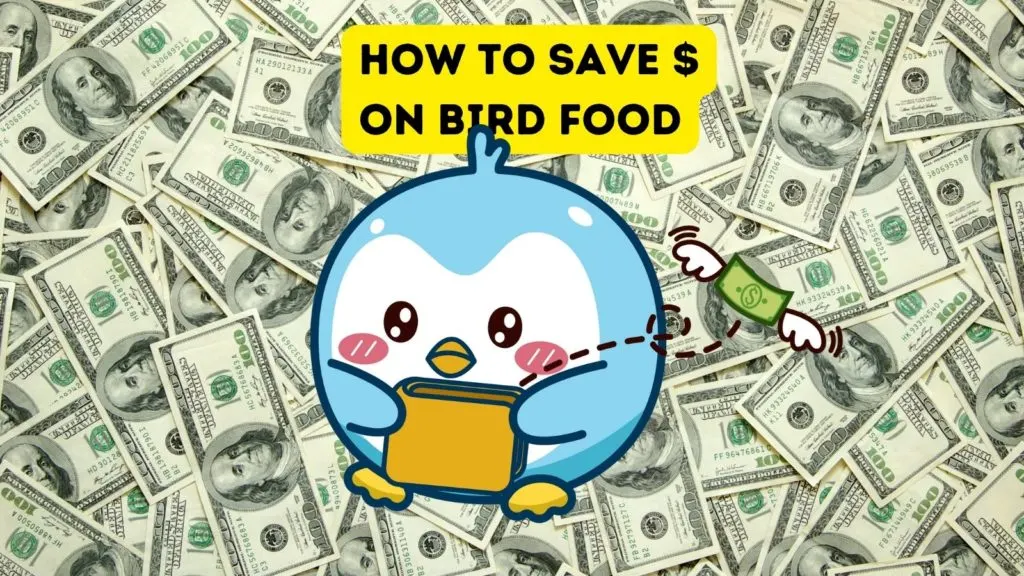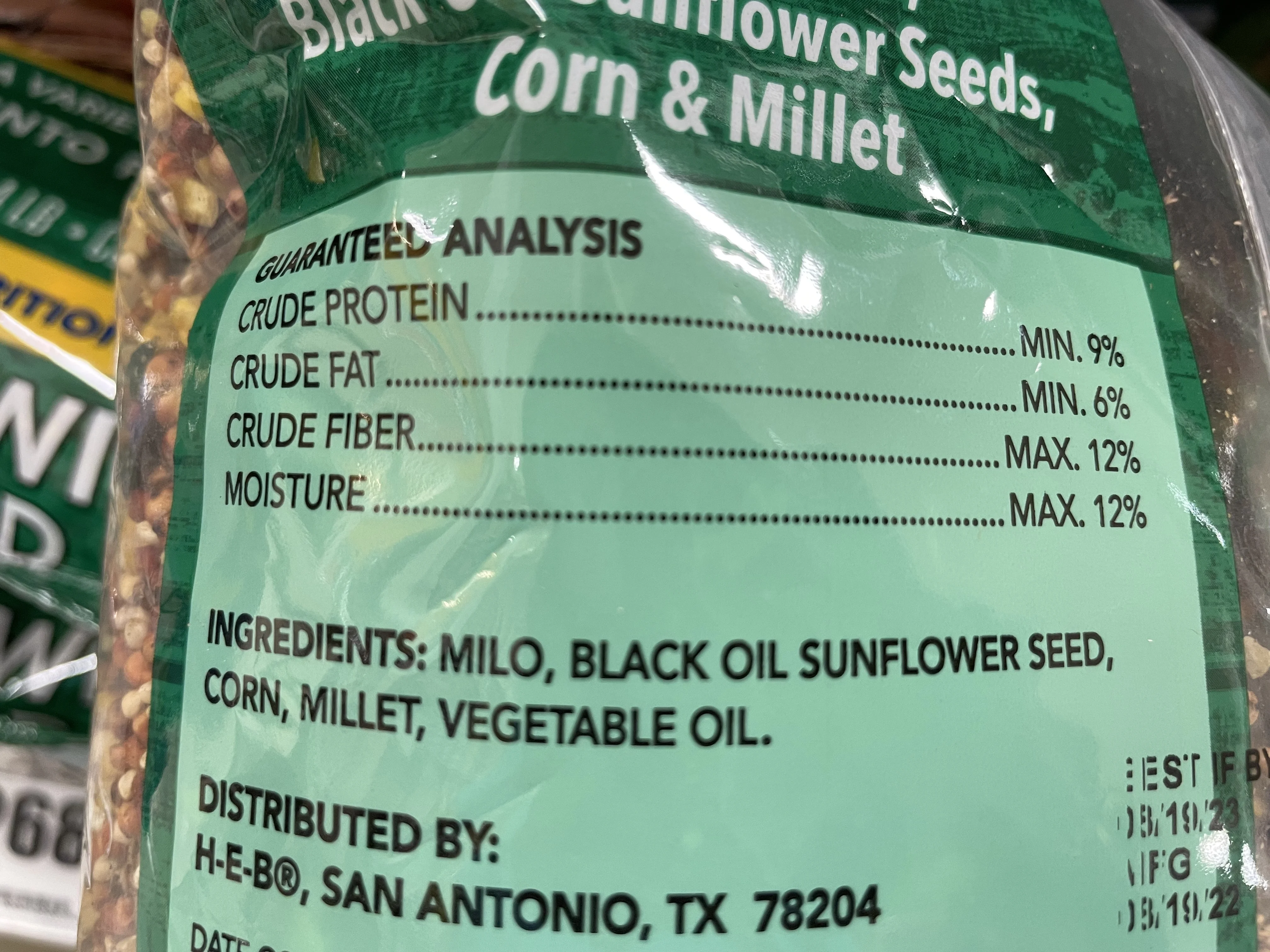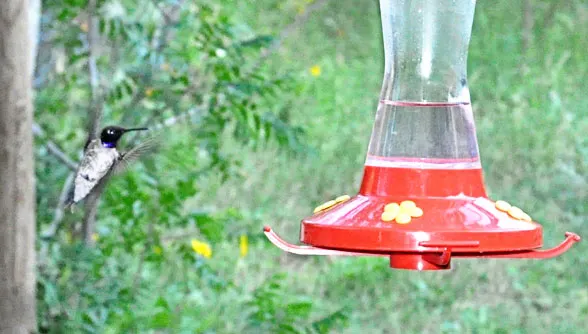Maintaining bird feeders can become costly, especially if you’re stocking more than one feeder. (And we all know the pain of looking at those prices at the grocery store!) Fortunately, there are several strategies to save money on bird food while still providing for your feathered friends. Let’s look at ways you can reduce your spending while still enjoying the fun of backyard bird feeding.

Smart Shopping at the Grocery Store
Bulk Purchases: Look for bird seed in bulk sections of the grocery store. Bulk purchases often come at a lower price per unit. Be sure to store excess seed properly to prevent it from going stale or attracting pests.
Alternative Seeds: Some birds are not picky eaters and will be happy with cheaper seeds. And some birds are VERY picky and will throw the unwanted seeds out of the feeder and to the ground.
One of those often unwanted foods is milo. Milo, also known as sorghum, is a type of grain that often finds its way into commercial bird seed mixes, particularly those aimed at a broad range of species.
Doves and wild turkeys love milo–but if that’s not what you’re expecting at your bird feeders, you may be wasting money with bird seed mixes that contain milo. Milo may end up uneaten, accumulating beneath feeders and potentially attracting pests.

Check the back of the bird seed mixes you are considering. If you see milo and you’re not attracting ground feeding birds, keep shopping for another mix that doesn’t contain milo. Even if the other mix is a bit more expensive, it will last longer and without the waste of the milo mix.
Sales and Discounts: Keep an eye out for sales, coupons, and discounts on bird food. Many stores have seasonal sales, especially at the end of the bird-feeding season or during general pet care promotions.
Check Out Feed Stores
Purchasing bird seed at a feed store can often be less expensive than buying it at a grocery store or specialty birding shop. Feed stores typically cater to a clientele looking for agricultural and livestock supplies, including bulk purchases, which can lead to lower prices.
- Bulk Purchases: Feed stores are more likely to sell bird seed in larger quantities. Buying in bulk usually reduces the cost per pound or kilogram, offering significant savings over smaller, pre-packaged amounts sold in other retail environments. You’ll need to pay extra attention to safe storage for the food since you are buying in bulk, storing in a cool, dry location.
- Less Specialized Products: While specialty birding shops might offer a wide range of specific seed mixes tailored to attract certain types of birds, feed stores tend to stock more general products that cater to a broader spectrum of wildlife and farm animals. This lack of specialization can further reduce costs.
- Direct Supply Chains: Many feed stores have direct relationships with seed suppliers and manufacturers, allowing them to offer lower prices due to fewer middlemen. This is particularly true in rural areas or regions close to agricultural centers.
- Functional Packaging: The packaging for bird seed sold in feed stores is often more utilitarian, focusing on practicality rather than aesthetic appeal. The savings from not using fancy packaging are usually passed on to the consumer.
- Customer Base: Feed stores operate on a business model that anticipates frequent and voluminous purchases by farmers and ranchers, allowing them to offer competitive prices to attract and retain this customer base. While their primary audience may not be backyard birders, the pricing models still benefit those looking to purchase bird seed.
Consider a DIY Mix
If you don’t mind doing some work–and have the room for storage, a DIY mix of bird seeds can be economical and the best way to match your bird seed mix to the diet of your local backyard birds.
You can select the types of seeds and other items like peanuts that are the best fit for your bird population, then shop for each of these ingredients at their best prices, whether that’s at the feed store, grocery store or farmers’ market.
Here are some tips and ideas for making your own bird feed mixes:
Basic Ingredients for a Balanced Mix
- Black Oil Sunflower Seeds: A favorite among a wide variety of birds, including finches, cardinals, and sparrows. These seeds are high in fat, providing essential energy.
- Millet: White and red millet are loved by ground-feeding birds like doves, juncos, and sparrows. It’s a small seed that’s easy for many birds to eat.
- Cracked Corn: Attracts larger birds such as turkeys, ducks, and pheasants, as well as smaller birds when used sparingly. It’s economical but should be used in moderation to avoid attracting pests.
- Nyjer (Thistle) Seeds: Particularly appealing to finches and siskins, these tiny seeds are rich in oil and nutrients.
- Peanuts: Whole or crushed, unsalted peanuts are a hit with woodpeckers, nuthatches, and titmice. Ensure they are fresh and free from mold–and unsalted.
Specialty Additions
Suet: High in fat, suet is excellent for winter feeding, providing vital energy to birds during the colder months. You can create your own suet cakes by melting fat (unsalted and not rancid) and mixing it with seeds and grains.
Dried Fruits: Raisins, cranberries, or chopped apples can attract fruit-eating birds like robins, bluebirds, and waxwings. Ensure fruits are unsweetened and chopped into small, manageable pieces.
Dehydrators (which often find their way to thrift stores) are easy to use and you can dehydrate a quite a bit at one time.
You can also often find imperfect fruits that are bruised or damaged at very low (or no) cost at some stores and farmers’ markets. While they may not be attractive to shoppers, damaged fruits are safe and perfect for slicing and dehydrating.
Tips for DIY Bird Feed Mixes
- Know Your Birds: Research which birds are common in your area and their dietary preferences. Tailoring your mix to local species increases the chances of attracting them.
- Quality Matters: Use fresh, high-quality ingredients to ensure the health and safety of your feathered visitors. Avoid anything salty, rancid, or moldy.
- Storage: Store your DIY mixes in cool, dry places to prevent spoilage or the attraction of pests. Airtight containers are best to keep the seeds fresh.
- Experiment: Don’t be afraid to experiment with different combinations and observe what works best. Bird preferences can vary by region and season.
By preparing your own bird feed, you not only save money but also create a closer connection to the birds visiting your yard. Plus, it allows for a more personalized approach to bird feeding, letting you adjust your offerings based on the changing seasons and the specific needs of your backyard bird community.
Adjusting Seed Distribution Seasonally
During spring and summer, birds have access to a wide range of natural food sources. You can reduce the amount of seed you distribute during these times.
Save the majority of your bird feeding budget for feeding during the winter months when birds benefit most from the supplemental food due to scarce natural resources.
It’s essential to recognize that feeder food only constitutes a percentage of a bird’s diet. Birds also consume insects, fruits, and natural seeds. Providing a bird-friendly habitat with native plants and water sources will also attract birds during a time when your bird feeder offerings are less abundant.
Incorporate native plants that attract insects, which in turn provide a natural food source for birds, especially during the breeding season when they need protein-rich diets for their young.
Consider Hummingbird Feeders

If hummingbirds frequent your area during part of the year, consider adding a hummingbird feeder to your bird feeding station.
Hummingbird food is just sugar and water, a very inexpensive way to bring the exotic beauty of hummingbirds to your feeding station! You will need to change the hummingbird food every couple of days but the cost is very inexpensive.
Waste Not, Want Not
One common mistake that can lead to waste and potentially endanger birds is overfilling feeders, especially if the seeds then get wet from rain or snow.
Wet bird seed can quickly mold, and moldy seeds can be harmful, even fatal, to birds. Mold produces toxins that can lead to respiratory issues and other health problems in birds.
Additionally, wet, clumped seed can clog feeders, making it difficult for birds to access the food.
To prevent these issues and the waste caused when you have to dump the wet seed in the trash, it’s best to fill feeders only with the amount of seed that birds can consume in one or two days. This also helps prevent mice, raccoons, opossums and other bird feeder visitors.
Embracing backyard birding doesn’t have to break the bank. By applying smart shopping strategies, exploring alternative sources for bird food, adjusting your feeding practices seasonally, and enhancing the natural attractiveness of your backyard, you can enjoy the presence of birds without overspending on feed!
More Posts You Might Like
- 8 Letter Bird Names - August 14, 2024
- 7 Letter Bird Names - August 14, 2024
- 7 Birds Named After Famous People - July 23, 2024
